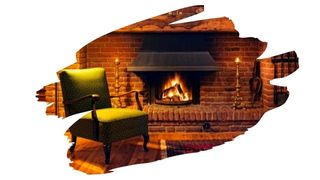If you want to heat up your home, without risking your health, you should only use clean burning firewood. That said, what exactly makes for clean burning lumber?
Let’s take the notorious Camphor tree, for example. The lumber of this tree is both favoured and feared in equal measure. But, is Camphor woods toxic reputation at all warranted?
Well, in this post, we first dive into what makes for good clean safe burning firewood. We then reveal the little-known FDA-banned substance that can be found saturating the grain of certain subspecies of Camphor trees.
And, finally, you will then learn whether or not Camphor wood is really safe enough to burn inside your home.

This post may contain affiliate links to products that we receive a commission for (at no additional cost to you). Learn more here.
What Is The Best Type of Firewood For The Fireplace?
Well, good firewood should meet three key criteria;
1). Firewood Needs To Emit A Low Amount of Smoke
There is nothing wrong with logs releasing smoke, that is what the chimney is there for. But once a log starts to bellow out smog, (and you’re coughing on those fumes), it becomes a whole other matter.
To prevent excessive smoke, you should only burn very dry firewood. If there’s a lot of moisture or sap still left in firewood, it will release an excessive amount of smoky fumes.
2). Firewood Needs To Have Very Little Sap Or Pitch
The sap and pitch inside wood can become a real problem if it drifts up into a chimney. Throw a pitch-filled log into that fireplace, and over time, that pitch build-up will block your chimney.
That blockage, in turn, creates a very real hazard in the form of a chimney fire.
That’s because pitch-filled soot residue will gum up your chimney. And that will skyrocket the risk of your chimney combusting.
3). Firewood Needs To Be Made From Non-Toxic Wood
Some types of trees are outright poisonous. Others are carcinogenic. Others still are severe sensitizers (meaning that they can cause allergic reactions if they come in contact with your skin).
You see, burning toxic wood doesn’t burn away those harmful toxins and dangerous compounds. Instead, the fumes and soot from them will continue to contain these dangerous compounds.
In other words, never turn toxic trees into firewood.
Related Post: Is Aspen Wood Really Any Good As Firewood? (Revealed!)
What Wood Is The Healthiest To Burn In An Indoor Fireplace?
The safest clean burning woods are Oak and Birch.
Not only do they meet the above 3 criteria, they are both quite dense woods too. Which means they will burn hotter (and for longer) than lower density wood.
So, Oak and Birch are not toxic, plus they have very little sap or pitch in them. And they can be dried, seasoned, and ready to burn, in as little as a year
What About Camphor Wood? What Is Camphor Wood Good For?
This evergreen tree is used for wood turning, and fine relief-carved furniture.
Also, oils from the Camphor tree are sometimes used as topical medicine to sooth itchiness and pain. Although, this medicinal essential oil is a highly refined and distilled version of the tree oil.
But, Is Camphor A Good Firewood? Is It OK To Burn Camphor In The Fireplace?
Remember how one of the three things we look for in firewood is a lack of toxicity? Well, Camphor wood fails in this regard. And it fails hard.
Camphor wood contains a compound so carcinogenic, that the FDA (U.S. Food and Drug Administration), banned this compound from being added to any products.
This compound is called ‘Safrole‘, and it is found naturally in a lot of everyday ingredients, such as nutmeg and black pepper. And, in very small doses, it poses a low health-risk.
But, here’s the thing. Some subspecies of Camphor trees, (especially ones native to Australia), have very high concentrations of Safrole in them. And if you inhale Safrole-filled fumes, it could cause very severe health effects.
Does That Mean Camphor Wood Is Toxic?
If you burn it and inhale it, yes it is. It will cause respiratory problems in the form of asthmatic reactions.
And, in some cases, it can even cause skin irritations too.
So, Camphor Trees Make For Bad Firewood…Right?
Yes, it is a poor choice for firewood.
Simply stick to clean burning firewood, such as Oak or Birch, if you want your fireplace to keep your home safe and warm.
Related Post: Is Redwood Good For Firewood? (Here’s What You Need To Know)
To Sum Up, Here Are The 3 Key Takeaways From This Post…
- 1). The safest type of firewood comes from non-toxic wood that has little sap or pitch.
- 2). Some subspecies of Camphor trees have a high concentration of Safrole, which is a very carcinogenic substance.
- 3). Burning Camphor wood in your home will produce smoke that may contain Safrole.
References:
Advice to the Minister for the Environment and Heritage from the Threatened Species Scientific Committee (TSSC) on Amendments to the List of Key Threatening Processes under the Environment Protection and Biodiversity Conservation Act 1999 (EPBC Act)



